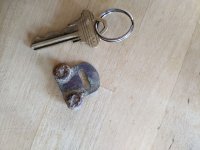Old Bookaroo
Silver Member
- Dec 4, 2008
- 4,318
- 3,510
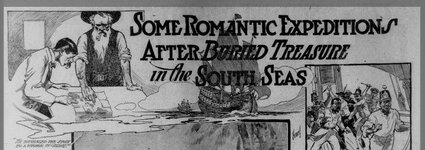
UNCHARTED Islands of the sea, hiding mysterious buried treasures, are a favorite theme of novelists, but one scarcely expects to meet them in real life. They seem rather to be designed by a considerate Providence for rewarding the hero in the last chapter and enabling him to marry the heroine. And yet buried treasures, as mysterious as any that ever figured In the most romantic tales, do exist in the Islands of the Pacific, and numerous expeditions have gone out from San Francisco with the purpose of finding them. It may be urged that just now San Francisco people can do just as well with a pick and shovel right here in the city, and have no need of going across the sea for the treasures that are buried, but if any one Is romantically inclined there is a Spanish galleon full of dollars waiting for him in the Galapagos Islands. It is only necessary to charter a vessel, hire a trusty crew and an expert diver carrying with him all the paraphernalia of his trade, then set sail for the Islands. There is a chance for as stirring adventures as befell the hero of W. Clark Russell's "List, Ye Landsmen," when be voyaged after the Spanish galleon full of dollars in a vast cave on an uncharted island near Galapagos. Indeed, it is likely that any one attempting to raise this later treasure would have even more exciting experiences, for he would have to draw it up from the bottom of the sea, and that is the reason why it has been allowed to remain so long where it is.
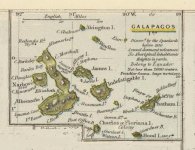
The Atlas of India, revised by J. Walker ...[London: 1856] - Tower (Genovesa today) Island is shown as "Euro." Hood Island is known today as "Espanola." There is a Chatham Bay on Cocos Island.
Discovers a Wrecked Galleon.
Captain Parker of San Francisco, who has been cruising around the Galapagos Islands whaling for sperm oil, reports that in clear weather he could plainly see the wreck of a Spanish galleon under the water, close to the weather side of Hood Island. He picked up some coins, which evidently came ashore from the broken cases of the wreck and had been thrown up on land by the power of the waves. The coins were Spanish dollars, and it is supposed that the galleon came from Spain around Cape Horn, carrying money to pay off troops in Colombia or Panama. The vessel would pass not far from the Islands, and must have drifted on the rocky shore. Though there is never a gale in the locality, the strong currents and the fog are just as dangerous to mariners. The shore rises very abruptly out of the water, and close to the steep rocks the treasure ship Is sunk. It would require a diver's outfit and be expensive as well as difficult to lift her cargo. That is probably the reason why the story of it can be published today, since people who find hidden treasures do not usually proclaim the fact unless there is a fly in their ointment.
The Galapagos Islands seem to be a favorite place for burled treasures, for there are rumors of another nice little pile concealed on Tower Island. Alas, It is no longer there, but who took it? That is the question. The members of the scientific expeditions that have sailed from San Francisco to explore the islands know only that It was there, but it is gone, and they did not get it, more is the pity.
When the Lila and Mattie sailed from San Francisco in 1901, it carried picks and shovels for unearthing the treasure, which it seems Professor Harris and his learned colleagues had heard of in the East. After completing their scientific labors they were going to reward themselves with a whack at the burled dollars, but the trouble was, that they did not know the exact spot. While beating around the island for fresh water one day they saw a sloop mysteriously appearing from behind a point of land.
For a moment it was plainly visible, masts and all, then as suddenly and mysteriously vanished. This was something that needed to be Investigated by science. So a boat with six armed men was sent out from the Lila and Mattie and returned within an hour with the sloop in tow. It was manned by an Irishman who seemed to be the captain, a Portuguese and a native. They had been digging for treasures, the Irishman said, but though they had dug till their parched tongues hung out of their mouths they had found nothing. Here then was a confirmation of the report of the hidden wealth but instead of giving a clew to the location, it seemed to indicate that even learned professors would have a lot of trouble finding the spot. Perhaps the men of science did not have the true adventurous fortune-hunting spirit after all; at any rate they abandoned the quest. When the expedition was homeward bound Captain R. Lindbridge of the Lila and Mattie heard the whole story of the treasure from Captain T. Levick, then living on Charles Island. The Irishman and the Portuguese, who had been digging with the tongues out of their mouths, drop out of the story at this point and are not the same as the worthy pair that shall appear later.
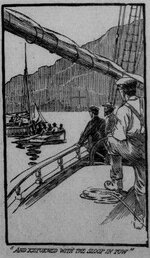
Captain Levick's blood-curdling tale is as follows: A small party of soldiers in Ecuador had been sent down the mountains carrying heavy loads of money for the Government to pay off the troops. But carrying on your back a load of the shiny metal big enough to make you live in blessed idleness ever after is said to be a peculiar sensation and has a tendency to weaken your moral -fiber. The soldiers woke up and found their moral fiber all but worn through with the strain. So they took both money and captain, got a vessel some way and sailed for the Galapagos Islands. Unfortunately it was necessary to let the sailors into the secret and the effect of the money on their morals was even worse than that experienced by the soldiers. There were mumblings and grumblings in the forecastle and much excited talk when no outsider was listening. At this point the story becomes a little blurred, but we all know that people from those volcanic South American countries are handy with the poison, the knife and the revolver. At any rate, when the forecastle plottlngs had been carried out, the soldiers who had abstracted the money in the first place were dead. So were the officers of the ship with the exception of the second mate, who had been left alive to navigate the vessel.
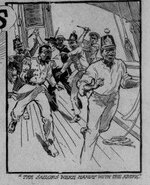
Kill Officer for His Share.
The sailors planned to divide the treasure between them and bury each his share. Then they would wreck the vessel and pass themselves off for deserving shipwrecked mariners. When they were all gathered in the cabin to divide the money bags, the second officer took upon himself to effect the distribution. Whenever he gave out a bag he kept one for himself, claiming that he was entitled to the lion's share because he was an officer. But in being so smart he overreached himself. The sailors reflected that if he were out of the way there would be so much the larger share for each of them, and furthermore, as they were going to wreck the ship they scarcely needed a navigator, destroying being proverbially easier than building up. They made no bones about killing the second officer, and then there were only six to share alike. They drifted on to Tower Island and buried the treasure there. But killing had become a habit with them- and presently, there were only four.
These were an Irishman, a Portuguese and two Chileans. They succeeded in wrecking the ship but one day the two Europeans overheard the Chileans plotting to murder them. To forestall this unpleasant experience which they had inflicted upon so many others being brought home to themselves they naturally pitched the two plotters overboard, and so there were two.
These two derelicts were destined to a long and strange companionship. They had to pass themselves off for sailors and invent some story that would take them away from the island. They succeeded in getting to California and from that time their constant aim was to establish connection with their hidden treasure. In the meantime they drifted to the mines and had a checkered career. Each lived in terror that his companion should sneak away and get possession of the whole treasure, so they never dared to lose sight of each other. Hating and distrusting, each other they yet lived closer together than brothers. At last the Portuguese died. The Irishman, whose name was Pete, had been a boy of 18 when he buried the treasure on Tower Island; now he was 70, and yet he had not entered into possession of his riches. He began to be afraid that he should die without ever seeing them again. So he revealed the story to a barber in Gilroy who had been kind to him.
Pete Leads an Expedition.
An expedition was organized and financed by the barber. Old Pete went with it to show the way. Though half a century had elapsed he had not forgotten the place that had once been indelibly fixed in his youthful memory. He went straight to the spot and found everything as it had been except that a cactus had grown over the burial place of the treasure. But Pete had grown suspicious of his companions, and perhaps recollecting what he had himself done in a similar position, he was afraid they might kill him when they had learned the position of the treasure. So long as he was the only one who knew he calculated that he was safe. Neither threats nor promises availed to make him reveal the place, and as he dared not do anything alone old Pete found himself with only a few feet of dirt between him and the treasure he had longed for all his life, yet as far away from it as ever. The expedition returned to Guayaquil, and on the way Pete confided in Captain Levick, who was in command of the vessel. He was coming back in a year, he said, to dlgup the treasure .
When the American expedition in the Lila and Mattle visited the islands two years had elapsed since the visit of Pete, from which Captain Levlck concluded that he must be dead. He therefore thought there could be nothing wrong with digging up the treasure and he advised the Americans to try it. Would seem from this story that hidden bags of gold and silver are about the most inconvenient form of the unrighteous mammon in which any one may indulge, since even if you do not fall a victim to the greed of someone else, it is possible to live as pauper all your life merely for lack of facility for getting at the treasure, though you know it is there and waiting for you. A moralist might point out that the lust after unearned wealth is the roof of more crime and suffering than can ever be recorded, but it is not supposed that these reflections will ever keep a single mortal from going after it when he has a chance. They did not deter the members of the Lila and Mattie expedition, although these men surely had all the proper reflections at their command. Being level-headed, however, they decided to make the digging for treasures a side issue, defraying the cost of the expedition through less uncertain channels.
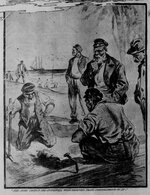
The next year the captain and mate with Professor Beck and other scientists of the expedition chartered the Mary Sachs and set out on another scientific expedition. They gathered many interesting specimens and made a good haul of the enormous tortoises of the Islands which sell for from two to four hundred dollars each; but when it came to looking after the buried treasure they found it impossible to land on Tower Island. They went home disappointed, but the treasure seemed to look better as it receded and they resolved to try yet another time. The Mary Sachs was chartered again, and this time she carried gasoline launches and a party of men determined to get to the island and see for themselves if there was any truth in the yarn they had been told. This time they succeeded in landing on the island and found the spot described by old Pete, cactus and all, everything, in fact, but the treasure. The sand on the beach is bleached by the sun to quite a snowy whiteness in the course of a few weeks, but in the place where the treasure should have been it was dark as if it had been freshly turned up by the space, and some object had evidently been removed from concealment in it.
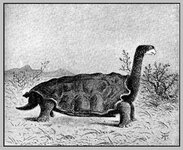
A Galapagos tortoise, drawn by Charles Darwin
Alas, They Were Too Late.
Then they knew that they were too late and had to console themselves with tortoises and science. The expedition returned to San Francisco covered with glory and specimens, but the true inwardness of the trip remained untold.
Who took the treasure? The members of the scientific expedition would like to know. It seems that there is a difference of between treasures in real life and in novels after all. In real life you get the excitement, the murders and the robberies and everything else that goes to make a sensational story, but the treasure itself melts away when you think it is within your grasp. An exception to this is the man Keating who is said to have abstracted forty thousand dollars worth of gold and precious stones from the famous Captain Kidd’s treasure on Cocos Island. Everybody has heard of Captain Kidd, the British naval officer who turned pirate, and it may be remembered that his island is not so very far from the Galapagos group as distances go in the vast ocean of the Pacific. A certain Captain Gessler is at present engaged in searching for the treasure. He has leased the island and has promised to pay the Nicaraguan Government royalties on what he gets. About the same time that Gessler set out for Cocos Island a man named Smith set out on an expedition with the schooner Harmony, said to be financed by prominent San Franciscans, to find a hidden treasure in the South Sea Islands. He returned without any treasure and got into trouble for obtaining money by false pretenses.
And now, who is next?
There must be other treasures hidden in the mysterious islands of the Pacific. At any rate, there is still Captain Parker’s galleon.
~ San Francisco Call, Volume 100, Number 164, 11 November 1906
Editor's Notes:
To suggest Capt. Kidd buried treasure on a South Sea island reflects the tendency of a great many writers to always associate his name with pirate plunder. It didn't happen. This is a precursor by almost a century to the Richard Knight debacle. The famous Cocos Island treasure hunter was August Gissler.
Good Luck to All,
The Old Bookaroo, CM
Last edited:





